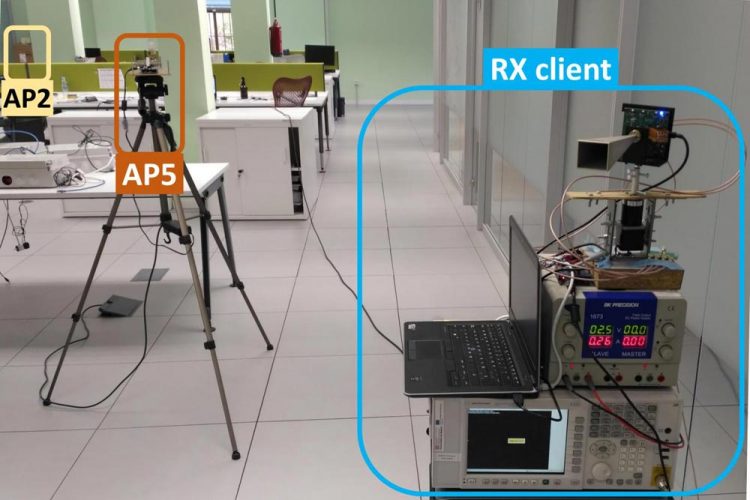Novel communications architecture for future ultra-high speed wireless networks

Figure 1. (first above) Photo of the open space measurement setup of Fig. 2, showing the client, AP2 (access point 2) and AP5 (access point 5). Credit: IMDEA Networks
The radio frequency spectrum, the basis for wireless telecommunications, is a finite resource that needs to be managed effectively to satisfy the demands posed by the exponential growth in wireless internet access.
IMDEA Networks researchers have developed a novel communications architecture for future ultrafast wireless networks that promises to achieve data rates previously only possible with optical fiber.
The radio frequency spectrum, the basis for wireless telecommunications, is a finite resource that needs to be managed effectively to satisfy the demands posed by the exponential growth in wireless internet access.
IMDEA Networks researchers have developed a novel communications architecture for future ultrafast wireless networks that promises to achieve data rates previously only possible with optical fiber.
Facebook initiated the Terragraph project that uses a mesh of reconfigurable millimeter-wave links to provide reliable, high-speed Internet access in urban and suburban environments. It previously experimented with networks of solar-powered drones with millimeter-wave backhaul and interconnection links to provide connectivity in areas with little infrastructure.
The Loon project by Alphabet (Google) uses high-altitude balloons with millimeter-wave links for the same purpose. Millimeter-wave technology also has extremely interesting properties for large scale networks of small satellites to provide world-wide connectivity, such as the planned Starlink network of SpaceX and PointView Tech (Facebook), and is very likely to be used in such networks. As density and capacity of such types of networks increases, the scalability results of this ERC project will be of high practical relevance.
“The ground breaking protocols and algorithms we have developed provide key elements for the scalability of future wireless networks,” says Joerg Widmer. “In analogy to the evolution of wired Ethernet from a shared medium to a fully switched network, we envision that future wireless networks will consist of many highly directional LOS (line-of-sight) channels for communication between access points (APs) and end devices”.
Thus, the architecture of future millimeter-wave networks will be characterized by being ultra-dense and highly scalable. “In order to deal with the extremely dynamic radio environments where channels may appear and disappear over very short time intervals, SEARCHLIGHT uses angle information to rapidly align the directional millimeter-wave antennas,” explains Dr. Widmer.
“The architecture integrates a location system and learns a map of the radio environment, which allows to rapidly select the most suitable access point and antenna beam pattern and allocate radio resource using predicted location as context information. Access points are deployed ubiquitously to provide continuous connectivity even in face of mobility and blockage and the project developed very low overhead network management mechanisms to cope with the high device density.”
Dr. Widmer, has recently awarded a H2020 Marie Sklodowska-Curie Innovative Training Network grant on “Millimeter-wave Networking and Sensing for Beyond 5G”, and within this project his group will follow-up on the promising work that was started during the ERC grant.
The work of the prestigious ERC grant also led to a collaboration project funded by Huawei on millimeter-wave and low frequency channel correlation and a sub-contracted project on a “Millimeter-wave SDR-based Open Experimentation Platform” within the framework of the H2020 project “Orchestration and Reconfiguration Control Architecture” (ORCA), to extend a FPGA based platform to less powerful hardware and enable remote access and experimentation for teaching and research.
###
More info:
* SEARCHLIGHT: https:/
* Personal site of Dr. Joerg Widmer: http://people.
* Wireless Networking Group at IMDEA Networks: http://wireless.
* Facebook's Terragraph project: https:/
* SpaceX's Starlink network: https:/
* Alphabet's (Google) Loon Project: https:/
* Facebook's PointView Tech: https:/
Media Contact
All latest news from the category: Information Technology
Here you can find a summary of innovations in the fields of information and data processing and up-to-date developments on IT equipment and hardware.
This area covers topics such as IT services, IT architectures, IT management and telecommunications.
Newest articles

Bringing bio-inspired robots to life
Nebraska researcher Eric Markvicka gets NSF CAREER Award to pursue manufacture of novel materials for soft robotics and stretchable electronics. Engineers are increasingly eager to develop robots that mimic the…

Bella moths use poison to attract mates
Scientists are closer to finding out how. Pyrrolizidine alkaloids are as bitter and toxic as they are hard to pronounce. They’re produced by several different types of plants and are…

AI tool creates ‘synthetic’ images of cells
…for enhanced microscopy analysis. Observing individual cells through microscopes can reveal a range of important cell biological phenomena that frequently play a role in human diseases, but the process of…





















